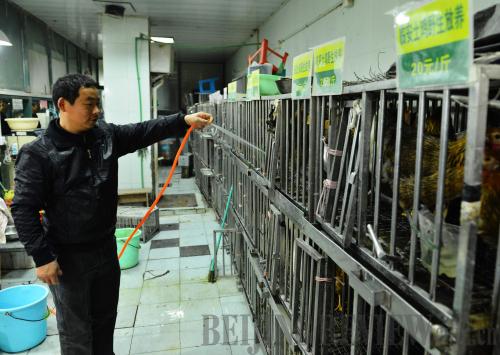|
 |
|
HEALTH CONSCIOUS: A live poultry merchant at a market in Hangzhou, east China's Zhejiang Province, sprays livestock with disinfectant on April 8 (LONG WEI) |
In some of the H7N9 cases, the infected people were found to have had contact with animals, he said, citing the appearance of the virus in pigeons in a Shanghai marketplace.
Though he admitted these cases indicate that the virus may have crossed from animals to humans, O'Leary said that the WHO does not deem it necessary at present to introduce screening measures at ports of entry or adopt any restrictive measures on tourism and trade.
He said that the public should maintain good hygiene and only eat properly cooked meat.
China has started research for the development of vaccines for the H7N9 bird flu virus, said Liang Wannian, Director of the H7N9 Influenza Prevention and Control Office under the NHFPC, at the press conference on April 8.
However, complications in the development and manufacturing process mean it may take about six to eight months before the vaccines can be distributed.
Liang said the decision to put the vaccines into production will depend on whether the virus can mutate to become human-to-human transmissible.
In its first edition of the H7N9 diagnosis and treatment guidance released on April 3, the NHFPC recommended the use of antiviral drugs, including neuraminidase inhibitors as well as some traditional Chinese medicine, on patients.
The CAS announced on April 9 that it has started researching how humans can avoid contracting the H7N9 virus. The project with joint efforts from nine CAS institutes focuses on H7N9's origin, mutations, pathogenesis and interactions with hosts, among other aspects.
These institutes will conduct scientific evaluations on immune system responses to the virus as well as the performances of antiviral drugs in the hope of accelerating the development of new medicines against the virus.
More transparency
Liang said that China is more prepared in handling public health emergencies than a decade ago when it fought severe acute respiratory syndrome (SARS) as the country's disease control network and related legislation have greatly improved. During the early stage of the SARS outbreak in 2003, which left more than 5,000 people in China infected, disease control efforts were greatly dampened by the lack of timely quarantine measures and cover-ups of some medical institutions and local governments.
Liang said that governments at all levels have been urged to be more transparent in releasing information on H7N9 bird flu cases.
He added that China reported the first case of H7N9 to the WHO soon after the case was confirmed and the country will accept site inspections, communicate with foreign experts, and provide strains of H7N9 avian influenza to the WHO in accordance with International Health Regulations.
At the same press conference, O'Leary said that the WHO had been in cooperation and communication with Chinese officials over the last two weeks.
"We are very satisfied and pleased with the level of information shared and we believe we have been kept fully updated on the situation," O'Leary said.
Information about H7N9 was made public by the NHFPC the day after the first infection was confirmed.
Since then, the commission has continued to update information on new infections on its official website, detailing the patients' age, location and treatment. It has also given the public tips on prevention.
"China has learned a lesson from the past in dealing with public health emergencies," said Professor Wang Yukai at the Chinese Academy of Governance.
"The government's response to the disease is completely different from 10 years ago, when information disclosure systems had not yet been established," Wang said.
Over the past decade, the Chinese Government has formulated a series of plans for handling infectious diseases and food safety incidents. A regulation for dealing with public health emergencies came out in May 2003, when the country was at a critical stage in combating SARS. China's Emergency Response Law went into force in November 2007. A regulation concerning government information disclosure took effect in May 2008, requiring the government to be more transparent in releasing information.
"The Chinese [National Health and Family Planning Commission] is working extremely openly and closely with us on this issue," said WHO spokesman Gregory Hartl at a news briefing in Geneva on April 9. "We are getting all the information that we need or ask for."
Email us at: lili@bjreview.com | 